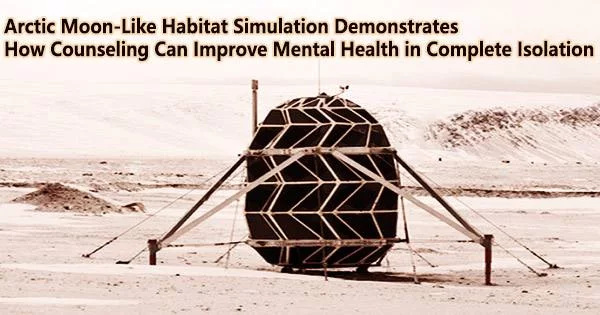SAGA Space Architects has teamed up with researchers from the Universities of Surrey and Milano-Bicocca to look at the psychological effects of social isolation in challenging environments, like the Moon. This study was a component of the LUNARK project, which investigated potential human habitats and means of survival on the Moon.
The LUNARK project was the first-ever Arctic simulation of a lunar mission. As part of the project, two space architects, Sebastian Aristotelis, and Karl-Johan Sørensen, designed an airtight, portable, foldable pod that enables its occupants to live self-sufficiently.
The architects spent 61 days in the pod starting in September 2020 in northern Greenland, a region that replicates the hostile terrain and subzero temperatures of the Moon. The arctic simulation’s visit from a neighborhood polar bear served as a test of the pod’s ability to endure external threats. The pod was also engineered to leave no environmental footprint.
The researchers assessed the men’s time perceptions, positive and negative emotions, levels of satisfaction with basic psychological needs (such as self-esteem and control), behavioral intentions (such as whether they displayed aggressive tendencies), and coping mechanisms in order to understand the effects of social isolation on the men.
To record this data, Sebastian and Karl-Johan kept daily diaries and completed a 20-minute questionnaire daily.
Konstantin Chterev, Psychology PhD student at Surrey and co-author of the study, said:
“Research to address the technical challenges of human missions into space is growing at a rapid rate. Therefore, it is critical that we explore the social-psychological aspects of individuals’ experiences of confinement within these habitats. We know that social isolation is among one of the main risk factors in these environments, but we still have a lot to learn.”
Space travel will likely become more frequent in the next few decades, due to the opening of the private market, NASA’s plans to send people to the Moon this decade, and government agencies in China and India joining the space travel race. With more organisations involved in sending people to space, we need more studies to focus on the mental health impacts involved in long missions in extreme and confined environments. Work like this will be able to inform future training and the planning of schedules in extreme environment expeditions and lunar missions, in which it is crucial to balance mission-critical tasks and physical wellbeing with protecting psychological wellbeing and mitigating the negative effects of long-term isolation.
Konstantin Chterev
The amount of communication the two space architects could have with the outside world was constrained. They had no access to the internet but could use a satellite phone to send daily messages (up to 160 characters) to the headquarters in Copenhagen, Denmark.
The findings revealed that positive feelings of estrangement, melancholy, helplessness, and unworthiness did not change over time for either of the space architects, although their desire for social contact did.
These negative sensations were linked to lessening while talking about private issues and doing leisure activities, but the need for social interaction grew. Furthermore, engaging in leisure activities increased the perceived speed of time.
Konstantin Chterev continued:
“Space travel will likely become more frequent in the next few decades, due to the opening of the private market, NASA’s plans to send people to the Moon this decade, and government agencies in China and India joining the space travel race. With more organisations involved in sending people to space, we need more studies to focus on the mental health impacts involved in long missions in extreme and confined environments.”
“Work like this will be able to inform future training and the planning of schedules in extreme environment expeditions and lunar missions, in which it is crucial to balance mission-critical tasks and physical wellbeing with protecting psychological wellbeing and mitigating the negative effects of long-term isolation.”





